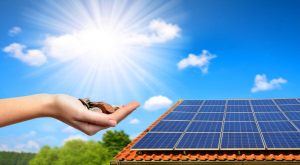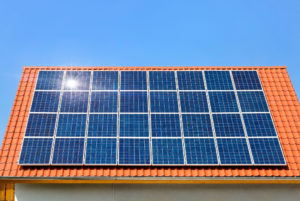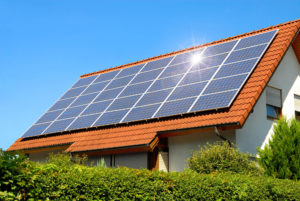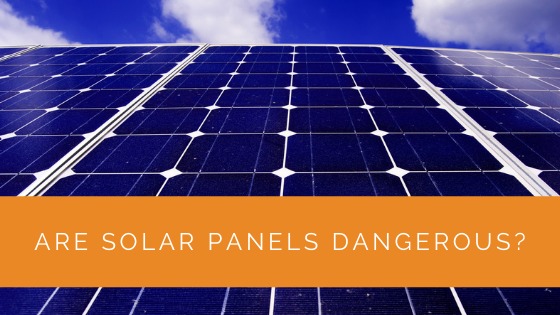Shifting to solar energy is becoming more and more popular by the day. Homeowners try to integrate clean energy into their lives by constructing solar panels on their roofs.
Even though solar energy is safe, efficient, and clean compared to power plants or traditional generators, the operation and production of solar panels are not necessarily safe or ecologically friendly.
The immense popularity of solar panels often makes homeowners ignore the inherent risks of a solar panel installation on their roofs. What are these potential threats that solar panels pose? Read this article to get a better idea of what you will be investing in before you choose to buy a solar energy collector panel.
Contents
Key Takeaways
- Solar panels are not inherently dangerous, but they come with certain risks and environmental concerns.
- The production and disposal of solar panels involve toxic materials and recycling challenges, posing risks to humans and the environment.
- Issues such as electrical hazards, fire risks, and difficulties for firefighters when panels are installed on rooftops should be considered when opting for solar panel installations.
What Are Solar Panels?
All the energy that we get from the sun is known as “solar energy.” It carries immense potential and is an eternal source of energy that is useful for day-to-day living.
Solar panels convert this light from the sun into electricity, which will further power electrical loads. Panels have various applications such as remote power systems for cabins, remote sensing, and electricity production by commercial and residential solar electric systems.
Are Solar Panels Dangerous?
It is difficult to label solar panels as overarchingly “dangerous” since they provide some undeniable benefits. However, it is important not to get swept away by these advantages and know some of the risks accompanying solar panels.
Toxicity
There is a tendency to assume that since solar panels convert sunlight into useable clean energy, environmentally clean materials probably constitute the panels themselves.
However, this is not the case. Arsenic and cadmium are the primary components used to make solar panels. The panel-making process may generate toxic and harmful byproducts, such as hexafluoride, sulfur, and silicon tetrachloride.
These dangerous byproducts are harmful to humans, domestic, and wild animals and can lead to respiratory conditions and illnesses. Moreover, they are also equally dangerous to the environment.

Electricity
Another issue that comes with solar panels is excess electricity. Any extra electricity that the solar panel produces goes straight to a battery or group of batteries. The only place to keep these batteries is inside the house.
These batteries can store up to 600 volts of direct electrical energy. Additionally, they remain charged even if after having been disconnected from the main energy collection system.
Mishandling these parts, particularly the batteries, can result in electrical damage, fires, and even possible death of human beings and animals in the vicinity of such an accident. A weak connection between these parts also poses a very real threat and can lead to similar life-threatening disasters.
Recycling Solar Waste
Much like the production of solar panels, the byproducts of their use are proving to be a recycling issue.
The biggest concern is to get rid of solar panels that are no longer functional. Throwing them into landfills is only a temporary solution.
If the landfills start to overflow, the used solar panels pose a severe threat to human life and the environment. Many countries are mandating that used solar panels have to undergo recycling, but this is still a process in the works, and there is a long way to go.
Installing Solar Panels
The process of installing the entire solar panel structure can be difficult since the panels are quite heavy. They are awkward to lift, and if done wrong, may result in strains, sprains, back injuries, or muscle pulls. There is the possibility of spine injury.
The solar panels also heat up within a short period when exposed to sunlight. That may lead to burns if one does not exercise caution while handling them.
However, with specific safety measures in place, you can avoid these injuries and risks:
- Apply safe lifting techniques and ensure that at least two people are lifting each solar panel.
- Use forklifts and mobile carts to transport the solar panels around the worksite (if required).
- Avoid climbing ladders with a solar panel in your hands. To get the panel onto the roof, use fully functioning and tested cranes, ladder-based winch systems, or hoists.
- After the unpacking of the panels, cover them up with an opaque sheet to prevent overheating.
- Ensure that you wear gloves at all times while handling solar panels.

Dangerous Components
Like most modern innovations and appliances, solar panels have a few components that are susceptible to failure and subsequent harm. For example, all solar panels will contain fuses, wiring, and switches.
If you find that these dangerous elements are not working according to expectations, get rid of them immediately and replace them with new parts that match the required standards.
Malfunctioning wires and switches carry the potential risk of electric shock and possibly even a fire breakout.
Earthing
While installing your solar panel system, you have two options – either you can connect it to an existing network or make it an entirely independent structure.
Whether you choose an existing network or an independent structure, your solar panels have to undergo the process of grounding. If you choose to skip this safety precaution or brush it aside as unimportant, your solar panel is at risk of electrical malfunction.
If you experience an electrical malfunction with your solar panel, your other electrical appliances may get damaged, particularly if they are all connected to an existing shared network. It may even lead to a fire.
Production of Greenhouse Gases
One of the most common byproducts of using a solar panel is nitrogen trifluoride, known to be about 17,000 times more capable than carbon dioxide at trapping solar energy.
The production of solar panels releases large amounts of nitrogen trifluoride, along with sulfur hexafluoride, which is the most potent greenhouse gas out of them all.
Manufacturers try to ensure that the process of solar panel production traps these harmful gases. However, any break in the confinement of the gases could lead to severe environmental damage and pose a risk to human and animal health.
Arc Faults and the Danger of Fire
Just like any other electrical system, fire is a hazard with solar panel systems. One of the most common causes of fire stemming from solar panels is electrical arc faults. These are high discharges of electricity between two or more conductors.
The heat released during this potential discharge may lead to a deterioration of the wire insulation, causing a spark or “arc” that will lead to a fire breakout.
Arc faults are of two types – series and parallel. A series arc fault occurs by the disruption in the continuity of a conductor. A parallel arc fault may come up when unintended current passes through conductors, possibly due to an error in grounding. Solar panels are subject to both.
To prevent a fire outbreak caused by arc faults, you may consider installing an arc fault circuit interrupter or circuit breaker. These devices can detect low-level arcing currents that pose a threat, and they will shut off the outlet entirely. That reduces the chances of an electrical fire caused by an arc fault.

Risk of Explosions
Since the solar panel carries medium to high-level voltages of electricity, there is also the risk of an arc flash. During an arc flash, hot gases and radiant energy release into the air and can reach up to four times the temperature of the sun’s surface.
It generally occurs when a large amount of energy is available to an arc fault. To reduce the risk of explosions caused by arc flash, consider using multiple string inverters instead of one or two large central inverters. These require combiner boxes, but with simultaneous AC and DC mitigation, you can avoid the risk of ark flash.
Explosions may also take place when the battery gets wet. Lead batteries are known to explode if they come in contact with water.
Issues on the Rooftop
The last point for you to consider before installing your solar panels is the difficulty maneuvering around the rooftop that these structures create.
Firefighters report that they have a hard time moving around on rooftops with solar panels installed on them, which delays the firefighting team’s emergency responsiveness.
Many firefighters also state that switching off solar panels is often a challenge because simple exposure to light keeps them energized. Under such circumstances, it becomes difficult to put out a fire due to these logistical issues posed by solar panels.
Case Study: Ensuring Safe Solar Panel Installation and Operation
Background
At Solar Panels Network USA, we prioritize safety in all our solar panel installations. Recently, we undertook a project for a residential client concerned about the potential dangers associated with solar panels. They wanted to ensure that their new solar energy system would be both efficient and safe for their family and home.
Project Overview
The client’s primary goal was to install a solar panel system that provided clean energy without compromising safety. They were particularly interested in understanding the potential risks and how to mitigate them effectively.
Implementation
We approached the project with a comprehensive safety plan, addressing all potential hazards and ensuring compliance with safety standards.
- Safety Audit and Risk Assessment: We conducted a thorough safety audit and risk assessment of the client’s property. This included evaluating the roof structure, potential electrical hazards, and environmental factors that could affect the installation and operation of the solar panels.
- System Design and Component Selection: Based on the safety audit, we designed a solar panel system that minimized risks. We selected high-quality, certified components with built-in safety features, such as arc fault circuit interrupters and properly rated fuses and switches.
- Installation Safety Measures: During the installation, we implemented strict safety protocols. Our team used safe lifting techniques and appropriate equipment to handle the heavy panels, ensuring no strain or injury. We also made sure the panels were installed with adequate spacing to allow for easy access and maintenance.
- Electrical Safety: We carefully installed and grounded all electrical components to prevent potential electrical shocks and fires. The system included multiple string inverters to reduce the risk of arc flashes and ensure a safer energy conversion process.
- Environmental Considerations: We addressed the environmental impact by selecting panels with a lower toxicity profile and ensuring proper disposal methods for any waste materials. The installation plan also included provisions for future recycling of the panels.
- Emergency Protocols: To enhance safety, we incorporated easy-to-access shutdown switches and clear labeling of all components. We also provided the client with a detailed emergency response plan, including instructions on how to safely shut down the system in case of an emergency.
Results
The project was completed successfully, with the solar panel system meeting all safety standards and providing the client with peace of mind. Key outcomes included:
- Enhanced Safety: The comprehensive safety measures implemented during the project ensured that the solar panel system operated safely and efficiently. The client was confident in the system’s safety features and emergency protocols.
- Efficient Energy Production: Despite the additional safety features, the solar panel system delivered optimal energy production, significantly reducing the client’s reliance on grid electricity and lowering their energy bills.
- Environmental Benefits: The use of eco-friendly components and proper disposal methods minimized the environmental impact, aligning with the client’s commitment to sustainability.
- Improved Emergency Response: The clear labeling and accessible shutdown switches facilitated easy and safe operation, even in emergency situations. This ensured that firefighters and other emergency responders could quickly and safely manage any incidents.
Summary
This case study demonstrates the importance of incorporating safety measures into solar panel installations. By conducting a thorough risk assessment and implementing stringent safety protocols, Solar Panels Network USA ensures that our clients receive not only efficient and sustainable energy solutions but also peace of mind regarding their safety. Our commitment to safety and quality drives us to continuously improve our processes and deliver the best possible outcomes for our clients.
Expert Insights From Our Solar Panel Installers About the Safety of Solar Panels
While solar panels are generally safe, it’s essential to be aware of the potential electrical hazards during installation and operation. Proper training and adherence to safety protocols can significantly mitigate these risks.
Lead Solar Installer
Handling and disposing of solar panels require caution due to the toxic materials involved in their production. Ensuring proper recycling and disposal methods helps protect both human health and the environment.
Senior Solar Technician
Installing solar panels on rooftops can pose challenges for emergency responders. It’s crucial to design installations that allow easy access and safe shutdown procedures in case of a fire.
Solar Energy Consultant
Experience Solar Excellence with Us!
Trust in Solar Panels Network USA, where our seasoned experts deliver top-quality solar solutions for homes and businesses nationwide. With a legacy of countless successful installations and a commitment to sustainable energy, we’re your reliable partner in the solar journey. Ready for a brighter, eco-friendly future? Call us now at (855) 427-0058 and harness the power of the sun!
Conclusion
While going solar is applaudable and a step forward in the world of clean energy, it is necessary for you to remember all the points mentioned in this article so that you can make the most of your solar panels.
Risk is an inherent part of installing solar panels, and they will always pose a threat with the possibility of electrical shocks or fire breakouts.
However, if you exercise caution, you can easily ensure that your solar panel undergoes a safe installation with no room for possible danger. Hopefully, this article could answer a few of your queries regarding the safety of solar panels and how to mitigate threats!
About the Author
Solar Panels Network USA stands at the forefront of solar energy solutions, driven by a team of seasoned solar engineers and energy consultants. With over decades of experience in delivering high-quality solar installations and maintenance, we are committed to promoting sustainable energy through customer-centric, tailored solutions. Our articles reflect this commitment, crafted collaboratively by experts to provide accurate, up-to-date insights into solar technology, ensuring our readers are well-informed and empowered in their solar energy decisions.

